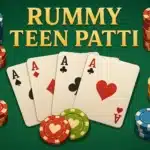Every day offers a chance to boost your chips count with our Teen Patti Stars Daily Bonus. By staying consistent, you could even earn up to 999 chips by the 7th day! Here’s how you can maximize this opportunity:

1. Teen Patti Daily Claims
Users can claim a Teen Patti Daily Bonus, but missing a day resets their progress to the start. Consistency is key!
2. Level Up for More Chips
Higher levels mean more chips, with up to 999 chips available by week’s end if you reach the top!
3. Don’t Miss Out After Midnight
Claim your chips daily after 12:00 AM; missing a day resets your progress to the start.
4. Complete Tasks for Extra Bonuses
Check out the TIPS section. Finish the tasks and unlock even more chip rewards.
5. Play Smart with Wagering
To fully enjoy your bonus, ensure you meet the wagering requirements.
6. One Bonus Per Account
To keep it fair, each player gets one account. That means one chance at the Daily Bonus.
7. Need Help? Ask Away
If you have any questions or concerns, our Customer Service Center is here to help. Reach out anytime for support!
Benefits of Playing Daily
Get Better at Games
The more you play, the more you learn. Each day of gameplay helps you improve and master the games.
Strategize with Bonuses
Using your daily bonuses strategically allows you to extend your playtime, giving you more chances to improve your skills. Longer sessions not only enhance your experience but can also increase your opportunities for bigger wins.
Stay in Routine
Logging in daily not only boosts your chip balance but also ensures you don’t miss out on rewards that can enhance your gameplay. It’s a great way to enjoy a fun, relaxing break while building consistency for bigger opportunities.
Stay Dedicated and Win
Daily Bonus is more than chips. It’s a reward for coming back day after day, with the big 999 chips as the ultimate prize for your dedication.
In simple terms, with the Daily Bonus Teen Patti, every day is a win. Stay consistent, play smart, and those 999 chips could be yours in no time!
Consistency in Gaming: Why It’s Your Best Strategy
Every game is an adventure, every move a decision. But what truly makes a player stand out is consistency. Here’s why sticking to a routine can be your golden ticket:
1. Familiarity Breeds Skill
Playing daily helps you explore the ins and outs of the game, giving you a deeper understanding of its rules, strategies, and patterns. The more familiar you become, the better your decision-making and performance, increasing your chances of success.
2. Rack Up Those Rewards
Similar to the Daily Bonus, many game features are designed to reward players who log in consistently, encouraging regular participation. The longer you stay active, the more rewards and benefits you unlock, enhancing both your gameplay and overall experience.
3. Develop Gaming Strategies
With every game you play, you gain new insights into strategies, patterns, and techniques that can improve your gameplay. By playing daily, you’ll gradually develop a solid playbook of winning strategies, giving you an edge over opponents and boosting your chances of success.
4. Stay Ahead of the Curve
Games constantly evolve with new features, updates, and exciting challenges being added to keep the experience fresh and engaging. By playing daily, you stay in the loop, explore these additions firsthand, and never miss out on opportunities to enjoy the latest rewards or gameplay improvements.
5. Build a Community
Playing consistently not only sharpens your skills but also helps you connect with a community of fellow gamers who share your passion. Whether you exchange tips, discuss strategies, or simply enjoy some friendly competition, regular play fosters camaraderie and enhances the overall gaming experience.
6. Achievement Milestones
Many games offer badges, titles, or rewards for consistent play. These are not just badges of honor; they often come with perks!
7. Never Miss an Update
Regular players are always first to know about updates, new features, or special events.
Benefits of Consistent Gaming
Muscle Memory
Similar to training in a sport, playing regularly sharpens your reflexes and improves your decision-making skills within the game.
Event Participation
Many games host special events for holidays or milestones. Play daily, and you’re always ready to dive into these events.
Build Your Profile
A seasoned player profile not only earns respect in the gaming community but also offers unique in-game benefits.
Personal Growth
It’s more than just playing the game; consistency helps build discipline, focus, and commitment—skills that are valuable in everyday life as well!
In a nutshell, while every game is a new challenge, consistency in your gaming routine can set you on a path to mastery. Play regularly, reap the rewards, and enjoy the journey of becoming a top player!

Frequently Asked Questions (FAQs)
Teen Patti Star – Download install the app to play casino games and win tons of real cash!
Big Agent Plan – Unlock exclusive rewards, earn massive commissions, and grow your gaming network like never before.
Teen Patti Brands
Dhani Teen Patti — Your Card Adventure with Dhani
Exploring the World of Teen Patti Live
Happy Ace Casino | Teen Patti Stars
Happy Teen Patti — The Joyful Realm of Card Gaming
Meta Teen Patti | Teen Patti Stars
Real Teen Patti — Embark on a Card Gaming Journey
Rummy Ares APK | Teen Patti Stars
Rummy East APK | Teen Patti Stars
Rummy Master | Teen Patti Stars
Rummy Perfect | Teen Patti Stars
Slot Master APK | Teen Patti Stars
Teen Patti Circle | Teen Patti Stars
Teen Patti Club – A pass to Card Game Excellence
Teen Patti Glee – The Delight of Card Gaming
Teen Patti Gold | Teen Patti Stars
Teen Patti Live | Teen Patti Stars
Teen Patti Master | Teen Patti Stars
Teen Patti Octro | Teen Patti Stars
Teen Patti Sweet — Unleash Sweetness in Every Hand
Teen Patti Vungo | Teen Patti Stars
Teen Patti Winner — Unlocking Victory
Teen Patti Yes – Igniting Your Passion for Card Gaming
Read Our Blogs
- Discovering the Thrill of Rummy Teen Patti at Teen Patti StarsIgniting India’s Card Game Passion on Teen Patti Stars Rummy Teen Patti, beloved staples of Indian card gaming, bring strategy, skill, and camaraderie to life, captivating players across generations. On Teen Patti Stars, a dynamic platform launched in 2023, these games flourish in a digital realm tailored for Indian enthusiasts. Offering Return to Player (RTP)…
- Unveiling the Mechanics of Slot Games on Teen Patti StarsDiving into the World of Slots at Teen Patti Stars Slot games have become a cornerstone of online gaming in India, offering a whirlwind of vibrant visuals, thrilling mechanics, and the promise of substantial rewards. At Teen Patti Stars, a premier platform launched in 2023, slots deliver an immersive experience tailored for Indian players, featuring…
- Is Teen Patti Game Legit or Fake? My Deep Dive into the World of Online 3 PattiThe Night I Questioned Teen Patti’s Legitimacy It was a humid Mumbai evening, and I was chilling with friends over chai when someone mentioned playing Teen Patti online for real cash. As a fan of the card game from Diwali nights, I was intrigued but skeptical. Could a digital version of India’s beloved “Indian Poker”…
- Roulette Teen Patti: A Fusion of Tradition, Thrill, and Trust in Online GamingThe online gaming landscape in India has witnessed a remarkable evolution, blending traditional card games with modern innovations to captivate a diverse audience. Among these, Roulette Teen Patti stands out as a thrilling hybrid that merges the cultural charm of Teen Patti—a beloved Indian card game—with the fast-paced excitement of roulette. This unique game, offered…
- Rummy Teen Patti: The Ultimate Guide to Two Iconic Card GamesIndia’s love for card games is timeless, with Rummy and Teen Patti reigning as two of the most cherished pastimes. These games, deeply embedded in the country’s cultural fabric, have transitioned from festive gatherings to vibrant online platforms, captivating millions with their blend of strategy, skill, and excitement. Whether you’re a beginner eager to learn…
- Why Jhandi Munda Is More Than Just a Festival GameJhandi Munda, a traditional Indian dice game, has long been a staple of festive gatherings, from the vibrant celebrations of Dashain and Tihar to casual street-side play in India’s Northeast. But to dismiss it as merely a festival game is to overlook its rich cultural significance, strategic depth, and modern evolution into a global online…
- Crash Teen Patti: Your Ticket to Thrills, Strategy, and Epic WinsCrash Teen Patti is a modern adaptation of the traditional Indian card game Teen Patti, often referred to as Indian Poker. While the classic version revolves around forming the best three-card hand, Crash Teen Patti shifts the focus to a multiplier-based betting system inspired by crash gambling games. Players place wagers on a multiplier that…
- Teen Patti: India’s Thrilling Card Game UnveiledTeen Patti, affectionately dubbed “Indian Poker,” remains a cultural cornerstone, weaving together strategy, psychology, and a hint of luck into an exhilarating card game. Evolving from its roots in the English game of three-card brag, it has grown from festive family gatherings to a global online phenomenon by 2025. Platforms like Teen Patti Stars are…
- Teen Patti Stars is Legit or Fake?Teen Patti, often called Indian Poker, is a beloved card game that has captured the hearts of millions in India and beyond. With its rise in popularity, online platforms like Teen Patti Stars have emerged, offering players a chance to enjoy this exciting game from the comfort of their homes. But a common question arises:…
- How to Trigger Free Spins and Bonuses in Crazy Seven Slots: A 2025 GuideAs of June 12, 2025, the online gaming world continues to evolve, with slot games like Crazy Seven Slots captivating players with their retro charm and tantalizing bonus features. Developed by Pragmatic Play, this classic-inspired slot combines nostalgic three-reel gameplay with modern twists, offering a unique experience for both novices and seasoned gamblers. Available on…












